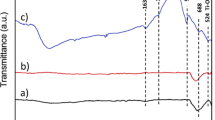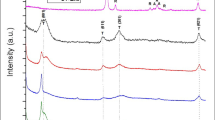Abstract
Herein, the effect of an acid pre-treatment over TiO2 reduction was studied to obtain black titania with increased defectives sites. A commercial TiO2 (anatase > 99%; Merck) was pre-treated with aqueous solutions of boric, nitric, phosphoric and sulfuric acids at 353 K. Afterwards, the solids were annealed for 2 h at 773 K under 50 mL min−1 H2 flow. The above materials were analyzed by XRD, FTIR, XPS and UV–Vis to relate the chemical changes induced by the acid pre-treatment with crystalline and optical characteristics and; hence, to the photoactivity. The O/Ti surface ratio nor the energy band gap value of the TiO2 was altered by the pre-treatment using sulfuric acid; therefore, the photocatalytic activity was not modified using this acid. Despite the fact that pre-treatment with boric and phosphoric acid decreased the energy band gap to 2.1 and 2.9; respectively (which is favorable for the absorption of visible light), the incorporation of borate and phosphate species in the surface was detrimental for the photocatalytic process. The O/Ti ratio dropped from 2.0 to 1.5 after the reduction of the sample pretreated with nitric acid. Since more oxygen vacancies are introduced by using nitric acid, the visible-light absorption was increased and the phenol photodegradation was boosted. The modulation of the defective sites allows to engineering the TiO2 band-gap for solar-driven applications.



Similar content being viewed by others
References
Vilar VJP, Pillai SC, Poulios I, Mantzavinos D, Pintar A (2020) Advanced oxidation processes: recent achievements and perspectives. Environ Sci Pollut Res. https://doi.org/10.1007/s11356-020-08929-4
Gholizadeh F, Dianat MJ, Izadbakhsh A (2020) Photocatalytic degradation of phenol using silica SBA-16 supported TiO2. Reac Kinet Mech Catal 130:1171–1192. https://doi.org/10.1007/s11144-020-01817-5
Bahrudin NN, Nawi MA (2018) Fabrication of immobilized powdered activated carbon as a sub-layer of TiO2 for the photocatalytic-adsorptive removal of phenol. Reac Kinet Mech Catal 124:153–169. https://doi.org/10.1007/s11144-017-1319-3
Ahmed S, Rasul MG, Martens WN, Brown R, Hashib MA (2010) Heterogeneous photocatalytic degradation of phenols in wastewater: a review on current status and developments. Desalination 261:3–18. https://doi.org/10.1016/j.desal.2010.04.062
Sakar M, Prakash R, Do TO (2019) Insights into the TiO2-based photocatalytic systems and their mechanisms. Catalysts 9:680. https://doi.org/10.3390/catal9080680
Cherni D, Ayedi S, Jaouali I, Moussa N, Nsib MF (2020) Preparation of solar/visible-light active TiO2 photocatalysts with carboxylic acids for the degradation of phenol. React Kinet Mech Catal 129:1091–1102. https://doi.org/10.1007/s11144-020-01756-1
Vilar VJP, Pillai SC, Malato S (2019) Solar chemistry and photocatalysis: environmental applications. Environ Sci Pollut Res 26:36077–36079. https://doi.org/10.1007/s11356-019-07334-w
Samsudin EM, Abd Hamid SB (2017) Effect of band gap engineering in anionic-doped TiO2 photocatalyst. Appl Surf Sci 391:326–336. https://doi.org/10.1016/j.apsusc.2016.07.007
El-Salamony RA, Gobara HM, Younis SA, Moustafa YM (2017) Zn2+-doped x-Ti–SiO2 tricomposites for enhancement the photo-catalytic degradation of phenol under UV irradiation. J Sol-Gel Sci Technol 83:422–435. https://doi.org/10.1007/s10971-017-4427-7
Onna D, Fuentes KM, Spedalieri C, Perullini M, Marchi MC, Alvarez F, Candal RJ, Bilmes SA (2018) Wettability, photoactivity, and antimicrobial activity of glazed ceramic tiles coated with titania films containing tungsten. ACS Omega 3:17629–17636. https://doi.org/10.1021/acsomega.8b03339
Ganduglia-Pirovano MV, Hofmann A, Sauer J (2007) Oxygen vacancies in transition metal and rare earth oxides: current state of understanding and remaining challenges. Surf Sci Rep 62:219–270. https://doi.org/10.1016/j.surfrep.2007.03.002
Liu B, Zhao X, Yu J, Parkin IP, Fujishima A, Nakata K (2019) Intrinsic intermediate gap states of TiO2 materials and their roles in charge carrier kinetics. J Photochem Photobiol C 39:1–57. https://doi.org/10.1016/j.jphotochemrev.2019.02.001
Khlyustova A, Sirotkin N, Kusova T, Kraev A, Titov V, Agafonov A (2020) Doped TiO2: the effect of doping elements on photocatalytic activity. Mater Adv. https://doi.org/10.1039/D0MA00171F
Colón G, Sánchez-España JM, Hidalgo MC, Navío JA (2006) Effect of TiO2 acidic pre-treatment on the photocatalytic properties for phenol degradation. J Photochem Photobiol A 179:20–27. https://doi.org/10.1016/j.jphotochem.2005.07.007
Kun R, Tarján S, Oszkó A, Seemann T, Zöllmer V, Busse M, Dékány I (2009) Preparation and characterization of mesoporous N-doped and sulfuric acid treated anatase TiO2 catalysts and their photocatalytic activity under UV and Vis illumination. J Solid State Chem 182:3076–3084. https://doi.org/10.1016/j.jssc.2009.08.022
Rajaraman TS, Parikh SP, Gandhi VG (2020) Black TiO2: a review of its properties and conflicting trends. Chem Eng J 389:123918. https://doi.org/10.1016/j.cej.2019.123918
Thompson TL, Yates JT (2005) TiO2-based photocatalysis: surface defects, oxygen and charge transfer. Top Catal 35:197–210. https://doi.org/10.1007/s11244-005-3825-1
Zhang K, Park JH (2017) Surface localization of defects in black TiO2: enhancing photoactivity or reactivity. J Phys Chem Lett 8:199–207. https://doi.org/10.1021/acs.jpclett.6b02289
Bi Q, Huang X, Dong Y, Huang F (2020) Conductive black titania nanomaterials for efficient photocatalytic degradation of organic pollutants. Catal Lett 150:1346–1354. https://doi.org/10.1007/s10562-019-02941-1
Aïnouche L, Hamadou L, Kadri A, Benbrahim N, Bradai D (2016) Ti3+ states induced band gap reduction and enhanced visible light absorption of TiO2 nanotube arrays: effect of the surface solid fraction factor. Sol Energy Mater Sol Cells 151:179–190. https://doi.org/10.1016/j.solmat.2016.03.013
Liu H, Ma H, Li X, Li W, Wu M, Bao X (2003) The enhancement of TiO2 photocatalytic activity by hydrogen thermal treatment. Chemosphere 50:39–46. https://doi.org/10.1016/S0045-6535(02)00486-1
Zhou X, Liu N, Schmuki P (2014) Ar+-ion bombardment of TiO2 nanotubes creates co-catalytic effect for photocatalytic open circuit hydrogen evolution. Electrochem Commun 49:60–64. https://doi.org/10.1016/j.elecom.2014.09.013
Teng F, Li M, Gao C, Zhang G, Zhang P, Wang Y, Chen L, Xie E (2014) Preparation of black TiO2 by hydrogen plasma assisted chemical vapor deposition and its photocatalytic activity. Appl Catal B 148–149:339–343. https://doi.org/10.1016/j.apcatb.2013.11.015
Khanam R, Taparia D, Mondal B, Mohanta D (2016) Black titania: effect of hydrogenation on structural and thermal stability of nanotitania. Appl Phys A 122:92. https://doi.org/10.1007/s00339-016-9618-5
Ross JRH (2019) Catalyst characterization. Contemp Catal. https://doi.org/10.1016/B978-0-444-63474-0.00005-9
Lee H-L, Flynn NT (2006) X-ray photoelectron spectroscopy. In: Viji DR (ed) Handbook of applied solid state spectroscopy. Springer, Boston, pp 485–507
Greenlief CM, White JM, Ko CS, Gorte RJ (1985) An XPS investigation of titanium dioxide thin films on polycrystalline platinum. J Phys Chem 89:5025–5028. https://doi.org/10.1021/j100269a027
Xiong L-B, Li J-LB, Yang YY (2012) Surface of titanium dioxide: generation, properties and photocatalytic application. J Nanomater 2012:1–13. https://doi.org/10.1155/2012/831524
Zhao D, Chen C, Wang Y, Ji H, Ma W, Zang L, Zhao J (2008) Surface modification of TiO2 by phosphate: effect on photocatalytic activity and mechanism implication. J Phys Chem C 112:5993–6001. https://doi.org/10.1021/jp712049c
Pap Z, Karácsonyi É, Cegléd Z, Dombi A, Danciu V, Popescu IC, Baia L, Oszkó A, Mogyorósi K (2012) Dynamic changes on the surface during the calcination of rapid heat treated TiO2 photocatalysts. Appl Catal B 111–112:595–604. https://doi.org/10.1016/j.apcatb.2011.11.012
Kumar PM, Badrinarayanan S, Sastry M (2000) Nanocrystalline TiO2 studied by optical, FTIR and X-ray photoelectron spectroscopy: correlation to presence of surface states. Thin Solid Films 358:122–130. https://doi.org/10.1016/S0040-6090(99)00722-1
Vijay M, Selvarajan V, Sreekumar KP, Yu J, Liu S, Ananthapadmanabhan PV (2009) Characterization and visible light photocatalytic properties of nanocrystalline TiO2 synthesized by reactive plasma processing. Sol Energy Mater Sol Cells 93:1540–1549. https://doi.org/10.1016/j.solmat.2009.04.004
Jun L, Shuping X, Shiyang G (1995) FT-IR and Raman spectroscopic study of hydrated borates. Spectrochim Acta A 51:519–532. https://doi.org/10.1016/0584-8539(94)00183-C
Jastrzębski W, Sitarz M, Rokita M, Bułat K (2011) Infrared spectroscopy of different phosphates structures. Spectrochim Acta A 79:722–727. https://doi.org/10.1016/j.saa.2010.08.044
Onoda H, Matsukura A (2015) Influence of concentration in phosphoric acid treatment of titanium oxide and their powder properties. J Asian Ceram Soc 3:27–31. https://doi.org/10.1016/j.jascer.2014.10.003
Zhang M, Dai Y, Zhang S, Chen W (2011) Highly efficient photocatalytic activity of boron-doped TiO2 for gas phase degradation of benzene. Rare Met 30:243–248. https://doi.org/10.1007/s12598-011-0278-5
Leshuk T, Parviz R, Everett P, Krishnakumar H, Varin RA, Gu F (2013) Photocatalytic activity of hydrogenated TiO2. ACS Appl Mater Interfaces 5:1892–1895. https://doi.org/10.1021/am302903n
Grabowska E, Zaleska A, Sobczak JW, Gazda M, Hupka J (2009) Boron-doped TiO2: characteristics and photoactivity under visible light. Procedia Chem 1:1553–1559. https://doi.org/10.1016/j.proche.2009.11.003
Nelson NC, Wang Z, Naik P, Manzano JS, Pruski M, Slowing II (2017) Phosphate modified ceria as a Brønsted acidic/redox multifunctional catalyst. J Mater Chem A 5:4455–4466. https://doi.org/10.1039/C6TA08703E
Park D-R, Zhang J, Ikeue K, Yamashita H, Anpo M (1999) Photocatalytic oxidation of ethylene to CO2 and H2O on ultrafine powdered TiO2 photocatalysts in the presence of O2 and H2O. J Catal 185:114–119. https://doi.org/10.1006/jcat.1999.2472
Jun J, Dhayal M, Shin J-H, Kim J-C, Getoff N (2006) Surface properties and photoactivity of TiO2 treated with electron beam. Radiat Phys Chem 75:583–589. https://doi.org/10.1016/j.radphyschem.2005.10.015
Xiong L-B, Li J-L, Yang B, Yu Y (2012) Ti3+ in the surface of titanium dioxide: generation, properties and photocatalytic application. J Nanomater 2012:1–13. https://doi.org/10.1155/2012/831524
Amano F (2017) Hydrogen reduced rutile titanium dioxide photocatalyst. In: Janus M (ed) Titanium dioxide. InTech, London, pp 101–115
Nawaz R, Kait CF, Chia HY, Isa MH, Huei LW (2019) Glycerol-mediated facile synthesis of colored titania nanoparticles for visible light photodegradation of phenolic compounds. Nanomaterials 9:1586. https://doi.org/10.3390/nano9111586
Kang X, Song X-Z, Han Y, Cao J, Tan Z (2018) Defect-engineered TiO2 hollow spiny nanocubes for phenol degradation under visible light irradiation. Sci Rep 8:5904. https://doi.org/10.1038/s41598-018-24353-8
Xing M, Fang W, Nasir M, Ma Y, Zhang J, Anpo M (2013) Self-doped Ti3+-enhanced TiO2 nanoparticles with a high-performance photocatalysis. J Catal 297:236–243. https://doi.org/10.1016/j.jcat.2012.10.014
Wang T, Zhang Y, Pan J, Li B, Wu L, Jiang B (2019) Hydrothermal reduction of commercial P25 photocatalysts to expand their visible-light response and enhance their performance for photodegrading phenol in high-salinity wastewater. Appl Surf Sci 480:896–904. https://doi.org/10.1016/j.apsusc.2019.03.052
Cao Y, Xing Z, Hu M, Li Z, Wu X, Zhao T, Xiu Z, Yang S, Zhou W (2017) Mesoporous black N-TiO2−x hollow spheres as efficient visible-light-driven photocatalysts. J Catal 356:246–254. https://doi.org/10.1016/j.jcat.2017.10.023
Wang S, Cai J, Mao J, Li S, Shen J, Gao S, Huang J, Wang X, Parkin IP, Lai Y (2019) Defective black Ti3+ self-doped TiO2 and reduced graphene oxide composite nanoparticles for boosting visible-light driven photocatalytic and photoelectrochemical activity. Appl Surf Sci 467–468:45–55. https://doi.org/10.1016/j.apsusc.2018.10.138
Hu M, Xing Z, Cao Y, Li Z, Yan X, Xiu Z, Zhao T, Yang S, Zhou W (2018) Ti3+ self-doped mesoporous black TiO2/SiO2/g-C3N4 sheets heterojunctions as remarkable visible-lightdriven photocatalysts. Appl Catal B 226:499–508. https://doi.org/10.1016/j.apcatb.2017.12.069
Acknowledgements
The authors acknowledge Santiago Marrero, Maria C. Goite and Ismael González for XRD, FTIR and XPS measurements, respectively. This project was funded by CDCH-UCV No. PG-03-0788-2013/1. KMF acknowledge CONACYT-México for the postdoctoral scholarship 2019-2020.
Author information
Authors and Affiliations
Corresponding author
Additional information
Publisher's Note
Springer Nature remains neutral with regard to jurisdictional claims in published maps and institutional affiliations.
Electronic supplementary material
Below is the link to the electronic supplementary material.
Rights and permissions
About this article
Cite this article
Fuentes, K.M., Venuti, D. & Betancourt, P. Black titania with increased defective sites for phenol photodegradation under visible light. Reac Kinet Mech Cat 131, 423–435 (2020). https://doi.org/10.1007/s11144-020-01832-6
Received:
Accepted:
Published:
Issue Date:
DOI: https://doi.org/10.1007/s11144-020-01832-6




